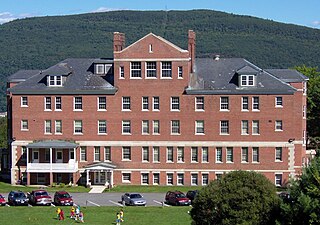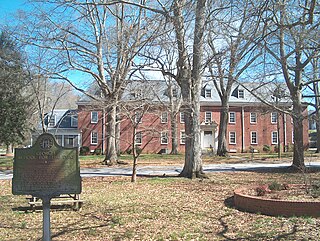
Beverly School for the Deaf is a school, established in 1876, for students from birth to age twenty-two who are Deaf, Hard-of-Hearing and/or have cochlear implants by providing language that is visually accessible via American Sign Language, written English, speech, and AAC/Assistive Technology. The school also serves students who have language issues caused by conditions such as autism spectrum disorder, pervasive developmental disorders, and cerebral palsy.
Bimodal bilingualism is an individual or community's bilingual competency in at least one oral language and at least one sign language, which utilize two different modalities. An oral language consists of an vocal-aural modality versus a signed language which consists of a visual-spatial modality. A substantial number of bimodal bilinguals are children of deaf adults (CODA) or other hearing people who learn sign language for various reasons. Deaf people as a group have their own sign language(s) and culture that is referred to as Deaf, but invariably live within a larger hearing culture with its own oral language. Thus, "most deaf people are bilingual to some extent in [an oral] language in some form" In discussions of multilingualism in the United States, bimodal bilingualism and bimodal bilinguals have often not been mentioned or even considered, in part because American Sign Language, the predominant sign language used in the U.S., only began to be acknowledged as a natural language in the 1960s. However, bimodal bilinguals share many of the same traits as traditional bilinguals, as well as differing in some interesting ways, due to the unique characteristics of the Deaf community. Bimodal bilinguals also experience similar neurological benefits as do unimodal bilinguals, with significantly increased grey matter in various brain areas and evidence of increased plasticity as well as neuroprotective advantages that can help slow or even prevent the onset of age-related cognitive diseases, such as Alzheimer's and dementia.
Bilingual–Bicultural or Bi-Bi deaf education programs use sign language as the native, or first, language of Deaf children. In the United States, for example, Bi-Bi proponents claim that American Sign Language (ASL) should be the natural first language for deaf children in the United States, although the majority of deaf and hard of hearing being born to hearing parents. In this same vein, the spoken or written language used by the majority of the population is viewed as a secondary language to be acquired either after or at the same time as the native language.

The Ohio School for the Deaf is a school located in Columbus, Ohio. It is run by the Ohio Department of Education for deaf and hard-of-hearing students across Ohio. It was established on October 16, 1829, making it the fifth oldest residential school in the country. OSD is the only publicly funded residential school for the deaf in Ohio.

The Atlanta Speech School is a language and literacy school located in Atlanta, Georgia, established in 1938. The school provides educational and clinical programs. The Atlanta Speech School's Rollins Center provides professional development for teachers and educators in partner schools and preschools. The Rollins Center focuses on the eradication of illiteracy. The Rollins Center has an online presence called Cox Campus, which is an online learning environment with coursework targeted for the education of children age 0–8.
Singapore Sign Language, or SgSL, is the native sign language used by the deaf and hard of hearing in Singapore, developed over six decades since the setting up of the first school for the Deaf in 1954. Since Singapore's independence in 1965, the Singapore deaf community has had to adapt to many linguistic changes. Today, the local deaf community recognises Singapore Sign Language (SgSL) as a reflection of Singapore's diverse linguistic culture. SgSL is influenced by Shanghainese Sign Language (SSL), American Sign Language (ASL), Signing Exact English (SEE-II) and locally developed signs.
The Vermont Center for the Deaf and Hard of Hearing, a non-profit organization, was the primary educational and support services resource for Deaf and Hard of Hearing residents in Vermont and surrounding areas. The Vermont Center, headquartered at Brattleboro’s Austin’s School For The Deaf, was launched by the Austine School in 1998 and operated until 2014. The Austine School was one of four independent schools and twelve outreach programs through which the Vermont Center assisted thousands of Vermonters who had hearing loss.
Delaware School for the Deaf (DSD) is a public K–12 school located on East Chestnut Hill Road in Brookside, Delaware, United States; It has a Newark postal address. The Christina School District operates the school, but because it is state-funded, the budget is separate from the rest of the district DSD operates Delaware Statewide Programs for the Deaf, Hard of Hearing, and Deaf-Blind.

The Austine School for the Deaf, now closed, in Brattleboro, Vermont, was an independent, coeducational day and residential school for deaf and hard-of-hearing children age four to eighteen from New England and New York.

Deaf education is the education of students with any degree of hearing loss or deafness. This may involve, but does not always, individually-planned, systematically-monitored teaching methods, adaptive materials, accessible settings, and other interventions designed to help students achieve a higher level of self-sufficiency and success in the school and community than they would achieve with a typical classroom education. There are different language modalities used in educational setting where students get varied communication methods. A number of countries focus on training teachers to teach deaf students with a variety of approaches and have organizations to aid deaf students.
Marion Downs was an American audiologist and Professor Emerita at the University of Colorado Health Sciences Center, Denver, who pioneered universal newborn hearing screening in the early 1960s, then spent more than 30 years trying to convince her peers to adopt the testing in hospitals and to place hearing aids on infants who showed hearing loss. She worked to alert the medical world to the developmental problems associated with childhood deafness. As a result of her efforts, 95 percent of all newborns in America today are screened for hearing loss. She devoted her professional life to the promotion of early identification of hearing loss in newborns, infants, and young children and to helping deaf and hard of hearing individuals lead fulfilling lives.

Georgia School for the Deaf (GSD) is a public residential school for the deaf. GSD provides comprehensive education and services to deaf and hard-of-hearing students between the ages of three and twenty-two. Located in Cave Spring, Georgia, United States, the school offers day and residential programs which meet the academic, social and physical needs of students in a bilingual environment. It was established in 1846 and is one of three public state schools operated by the Georgia Department of Education.
Robert J. Hoffmeister is associate professor emeritus and former director of the Center for the Study of Communication & Deafness at Boston University. He is most known for his book, Journey into the Deaf World. He is also known for supporting the American deaf community and deaf education.
The history of deaf education in the United States began in the early 1800s when the Cobbs School of Virginia, an oral school, was established by William Bolling and John Braidwood, and the Connecticut Asylum for the Deaf and Dumb, a manual school, was established by Thomas Hopkins Gallaudet and Laurent Clerc. When the Cobbs School closed in 1816, the manual method, which used American Sign Language, became commonplace in deaf schools for most of the remainder of the century. In the late 1800s, schools began to use the oral method, which only allowed the use of speech, as opposed to the manual method previously in place. Students caught using sign language in oral programs were often punished. The oral method was used for many years until sign language instruction gradually began to come back into deaf education.
Lexington School and Center for the Deaf comprises the Lexington School for the Deaf, the Lexington Hearing and Speech Center, Lexington Vocational Services, and the Lexington Center for Mental Health in New York City, aimed at serving the deaf and hard of hearing community.

Marie Jean Philip was a leader in both the American and international Deaf community. She advocated for the right to a natural sign language for Deaf people. Marie was one of the original researchers studying ASL and Deaf Culture. She was active in establishing American Sign Language (ASL) as a recognized language in the colleges of Massachusetts in the early 1980s. Later, Marie was the Bilingual-Bicultural Coordinator at The Learning Center for the Deaf in Framingham, Massachusetts.
HASA is a social benefit 501(c)(3) organization located in Baltimore, Maryland, that specializes in facilitating communication. Established in 1926, the organization provides special education services through Gateway School, audiology and speech-language services through its Clinical Services Department, and interpreting services for the deaf through its CIRS Interpreting Department.
Language deprivation in deaf and hard-of-hearing children is a delay in language development that occurs when sufficient exposure to language, spoken or signed, is not provided in the first few years of a deaf or hard of hearing child's life, often called the critical or sensitive period. Early intervention, parental involvement, and other resources all work to prevent language deprivation. Children who experience limited access to language—spoken or signed—may not develop the necessary skills to successfully assimilate into the academic learning environment. There are various educational approaches for teaching deaf and hard of hearing individuals. Decisions about language instruction is dependent upon a number of factors including extent of hearing loss, availability of programs, and family dynamics.
Kendall Demonstration Elementary School (KDES) is a private day school serving deaf and hard of hearing students from birth through grade 8 on the campus of Gallaudet University in the Trinidad neighborhood of Washington, D.C. Alongside Model Secondary School for the Deaf, it is a federally funded, tuition-free demonstration school administered by the Laurent Clerc National Deaf Education Center at Gallaudet University.
The Windward Islands consists of various islands located in the Caribbean Sea such as Dominica, Martinique, Barbados, Saint Lucia, Saint Vincent and the Grenadines, Trinidad and Tobago, and Grenada. It consists of various cultures, beliefs and languages.









